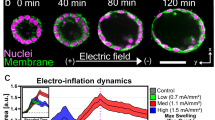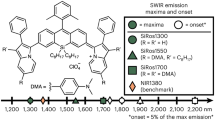Abstract
Dielectric multilayer reflectors that are non-polarizing are an important class of optical device and have numerous applications within optical fibres1, dielectric waveguides2 and light-emitting diodes3. Here, we report analyses of a biological non-polarizing optical mechanism found in the broadband guanine-cytoplasm ‘silver’ multilayer reflectors of three species of fish. Present in the fish stratum argenteum are two populations of birefringent guanine crystal, with their optical axes either parallel to the long axis of the crystal or perpendicular to the plane of the crystal, respectively. This arrangement neutralizes the polarization of reflection as a result of the different interfacial Brewster's angles of each population. The fish reflective mechanism is distinct from existing non-polarizing mirror designs4,5,6,7 in that, importantly, there is no refractive index contrast between the low-index layers in the reflector and the external environment. This mechanism could be readily manufactured and exploited in synthetic optical devices.
This is a preview of subscription content, access via your institution
Access options
Subscribe to this journal
Receive 12 print issues and online access
$209.00 per year
only $17.42 per issue
Buy this article
- Purchase on Springer Link
- Instant access to full article PDF
Prices may be subject to local taxes which are calculated during checkout




Similar content being viewed by others
References
Hart, S. D. et al. External reflection from omnidirectional dielectric mirror fibers. Science 296, 510–513 (2002).
Yang, S. H., Cooper, M. L., Bandaru, P. R. & Mookherjea, S. Giant birefringence in multi-slotted silicon nanophotonic waveguides. Opt. Express 16, 8306–8316 (2008).
Gessmann, T., Schubert, E. F., Graff, J. W., Streubel, K. & Karnutsch, C. Omnidirectional reflective contacts for light-emitting diodes. IEEE Electron. Dev. Lett. 24, 683–685 (2003).
Fink, Y. A Dielectric omnidirectional reflector. Science 282, 1679–1682 (1998).
Kaminska, K. & Robbie, K. Birefringent omnidirectional reflector. Appl. Opt. 43, 1–7 (2004).
Han, P. & Wang, H. Criterion of omnidirectional reflection in a one-dimensional photonic heterostructure. J. Opt. Soc. Am. B 22, 1571–1575 (2005).
Bria, D., Boudouti, E. H. E., Mir, A. & Akjouj, A. Omnidirectional optical mirror in a cladded-superlattice structure. J. Appl. Phys. 91, 2569–2572 (2012).
Cronin, T., Chiou, T-H., Caldwell, R. & Roberts, N. Polarization signals in mantis shrimps. Proc. SPIE 7461, 74610C (2009).
Jewell, S. A., Vukusic, P. & Roberts, N. W. Circularly polarized colour reflection from helicoidal structures in the beetle Plusiotis boucardi. New J. Phys. 9, 99 (2007).
Land, M. F. & Nilsson, D-E. Animal Eyes, Oxford Animal Biology Series, 1st edn (Oxford Univ. Press, 2002).
Denton, E. J. & Nicol, J. Polarization of light reflected from the silvery exterior of the bleak, Alburnus alburnus. J. Mar. Biol. Assoc. UK 45, 705–709 (1965).
Denton, E. J. & Nicol, J. A. C. Studies on reflexion of light from silvery surfaces of fishes, with special references to the bleak, Alburnus alburnus. J. Mar. Biol. Assoc. UK 45, 683–703 (1965).
Denton, E. J. Review Lecture: On the organization of reflecting surfaces in some marine animals. Phil. Trans. R. Soc. B 258, 285–313 (1970).
Denton, E. J. & Land, M. F. Mechanism of reflexion in silvery layers of fish and cephalopods. Proc. R. Soc. B 178, 43–61 (1971).
McKenzie, D. R., Yin, Y. & McFall, W. D. Silvery fish skin as an example of a chaotic reflector. Proc. R. Soc. A 451, 579–584 (1995).
Zhang, D., Li, Z., Hu, W. & Cheng, B. Broadband optical reflector—an application of light localization in one dimension. Appl. Phys. Lett. 67, 2431–2432 (1995).
Denton, E. J. & Nicol, J. A. C. Reflexion of light by external surfaces of the herring, Clupea harengus. J. Mar. Biol. Assoc. UK 45, 711–738 (1965).
Rowe, D. M. & Denton, E. J. The physical basis of reflective communication between fish, with special reference to the horse mackerel, Trachurus trachurus. Proc. R. Soc. B 352, 531–549 (1997).
Land, M. F. The physics and biology of animal reflectors. Prog. Biophys. Mol. Biol. 24, 75–106 (1972).
Levy-Lior, A. et al. Guanine-based biogenic photonic-crystal arrays in fish and spiders. Adv. Funct. Mater. 20, 320–329 (2010).
Born, M. & Wolf, E. Principles of Optics 7th edn, 40–49 (Cambridge Univ. Press, 1999).
Greenstein, L. Nacreous pigments and their properties. Proc. Sci. Sec. Toilet Goods Assoc. 26, 20–26 (1966).
Levy-Lior, A. et al. Biogenic guanine crystals from the skin of fish may be designed to enhance light reflectance. Cryst. Growth Des. 8, 507–511 (2008).
Berreman, D. 4 × 4 matrix methods. J. Opt. Soc. Am. 62, 502–510 (1972).
Azzam, R. M. & Bashara, N. M. Ellipsometry and Polarized Light, 269–363 (Elsevier, 1988).
Weber, M. F. Giant birefringent optics in multilayer polymer mirrors. Science 287, 2451–2456 (2000).
Orfanidis, S. Electromagnetic Waves and Antennas; available at http://www.ece.rutgers.edu/orfanidi/ewa/ (accessed September 2012)
Vukusic, P. & Sambles, R. J. Photonic structures in biology. Nature 424, 852–855 (2003).
Roberts, N. W., Chiou, T-H., Marshall, N. J. & Cronin, T. W. A biological quarter-wave retarder with excellent achromaticity in the visible wavelength region. Nature Photon. 3, 641–644 (2009).
Jen, Y-J. et al. Biologically inspired achromatic waveplates for visible light. Nature Commun. 2, 363 (2011).
Roberts, N. W., Porter, M. L. & Cronin, T. W. The molecular basis of mechanisms underlying polarization vision. Phil. Trans. R. Soc. B 366, 27–37 (2011).
Temple, S. E. et al. High-resolution polarization vision in a cuttlefish. Curr. Biol. 22, R121–R122 (2012).
Cronin, T. & Shashar, N. The linearly polarized light field in clear, tropical marine waters: spatial and temporal variation of light intensity, degree of polarization and e-vector angle. J. Exp. Biol. 204, 2461–2467 (2001).
Mäthger, L. M., Denton, E. J., Marshall, N. J. & Hanlon, R. T. Mechanisms and behavioural functions of structural coloration in cephalopods. J. R. Soc. Interface 6 (suppl 2), S149–S163 (2009).
Dacke, M., Nilsson, D., Warrant, E. J., Blest, A. D. & Land, M. F. Built-in polarizers form part of a compass organ in spiders. Nature 401, 470–473 (1999).
Colomb, T. et al. Polarization imaging by use of digital holography. Appl. Opt. 41, 27–37 (2002).
Acknowledgements
The authors acknowledge support from the Biotechnology and Biological Sciences Research Council (NWR – grant no. BB/G022917/1 and BB/H01635X/1), the Engineering and Physical Sciences Research Council (TMJ – grant no. EP/E501214/1) and the Air Force Office of Scientific Research (NWR – grant no. FA-9550-09-1-0149). The authors thank J. McGregor and S.E. Temple for valuable discussions and I.C. Cuthill for advice on statistical analyses.
Author information
Authors and Affiliations
Contributions
J.C.P. initiated the study. T.M.J and N.W.R. performed the modelling and experiments. All authors interpreted the data and co-authored the paper.
Corresponding author
Ethics declarations
Competing interests
The authors declare no competing financial interests.
Supplementary information
Supplementary information
Supplementary information (PDF 775 kb)
Rights and permissions
About this article
Cite this article
Jordan, T., Partridge, J. & Roberts, N. Non-polarizing broadband multilayer reflectors in fish. Nature Photon 6, 759–763 (2012). https://doi.org/10.1038/nphoton.2012.260
Received:
Accepted:
Published:
Issue Date:
DOI: https://doi.org/10.1038/nphoton.2012.260
This article is cited by
-
Macromolecular sheets direct the morphology and orientation of plate-like biogenic guanine crystals
Nature Communications (2023)
-
A highly reflective biogenic photonic material from core–shell birefringent nanoparticles
Nature Nanotechnology (2020)
-
Floating photonic crystals utilizing magnetically aligned biogenic guanine platelets
Scientific Reports (2018)
-
Polarisation vision: overcoming challenges of working with a property of light we barely see
The Science of Nature (2018)
-
Modelling Malpighian tubule crystals within the predatory soil mite Pergamasus longicornis (Mesostigmata: Parasitidae)
Experimental and Applied Acarology (2017)



